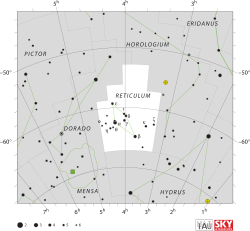Theta Reticuli is double star in southern constellation of Reticulum, located just 50′ south of Alpha Reticuli.[10] The pair are visible to the naked eye as a dim, white-hued point of light with a combined apparent visual magnitude of 5.88.[2] They lie at roughly the same distance from the Sun based on parallax, with the primary being around 466 light-years away. They also share a similar proper motion,[1][7] suggesting they may be gravitationally bound.[11]
| Observation data Epoch J2000.0 Equinox J2000.0 (ICRS) | |
|---|---|
| Constellation | Reticulum |
| Right ascension | 04h 17m 40.27169s[1] |
| Declination | −63° 15′ 19.4882″[1] |
| Apparent magnitude (V) | 5.88[2] 6.05 + 7.65[3] |
| Characteristics | |
| θ Ret A | |
| Spectral type | B9IV[4] |
| B−V color index | −0.09[3] |
| Variable type | suspected[5] |
| θ Ret B | |
| Spectral type | kA2hA5VmA7[4] |
| B−V color index | +0.14[3] |
| Astrometry | |
| θ Ret A | |
| Radial velocity (Rv) | 3.0±7.4[2] km/s |
| Proper motion (μ) | RA: +6.273[1] mas/yr Dec.: +35.360[1] mas/yr |
| Parallax (π) | 7.0053 ± 0.0401 mas[1] |
| Distance | 466 ± 3 ly (142.7 ± 0.8 pc) |
| Absolute magnitude (MV) | −0.04[6] |
| θ Ret B | |
| Proper motion (μ) | RA: +8.512[7] mas/yr Dec.: +35.235[7] mas/yr |
| Parallax (π) | 7.1837 ± 0.0540 mas[7] |
| Distance | 454 ± 3 ly (139 ± 1 pc) |
| Details | |
| θ Ret A | |
| Mass | 3.363±0.117[6] M☉ |
| Luminosity | 179[6] L☉ |
| Temperature | 11,967[6] K |
| Rotation | 2.9686[8] d |
| Age | 166[6] Myr |
| θ Ret B | |
| Mass | ≥ 1.18[6] M☉ |
| Temperature | 9,132[7] K |
| Age | 200[4] Myr |
| Other designations | |
| θ Ret A: NSV 1556, GC 5233, SAO 248986 | |
| θ Ret B: GC 5232, SAO 248985 | |
| Database references | |
| SIMBAD | data |
| A | |
| B | |
The magnitude 6.05[3] primary, designated component A, has a stellar classification of B9IV,[4] matching a B-type subgiant. It is 166 million years old with 3.4 times the mass of the Sun. The star is radiating 179 times the Sun's luminosity from its photosphere at an effective temperature of 11,967 K.[6]
As of 2015, the magnitude 7.65[3] secondary, component B, had an angular separation of 4.10″ from the primary along a position angle of 3°.[12] It is most likely a very young main-sequence star,[6] and is an Am star with a stellar classification of kA2hA5VmA7.[4] This notation indicates the spectrum displays the K-line of an A2-type star, the hydrogen lines of a cooler A5 star, and the metal lines of an A7 star. This system is a source of X-ray emission, which may be coming from the companion.[6]
